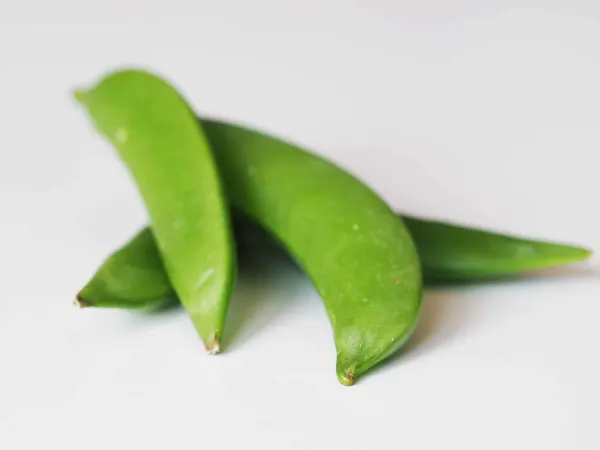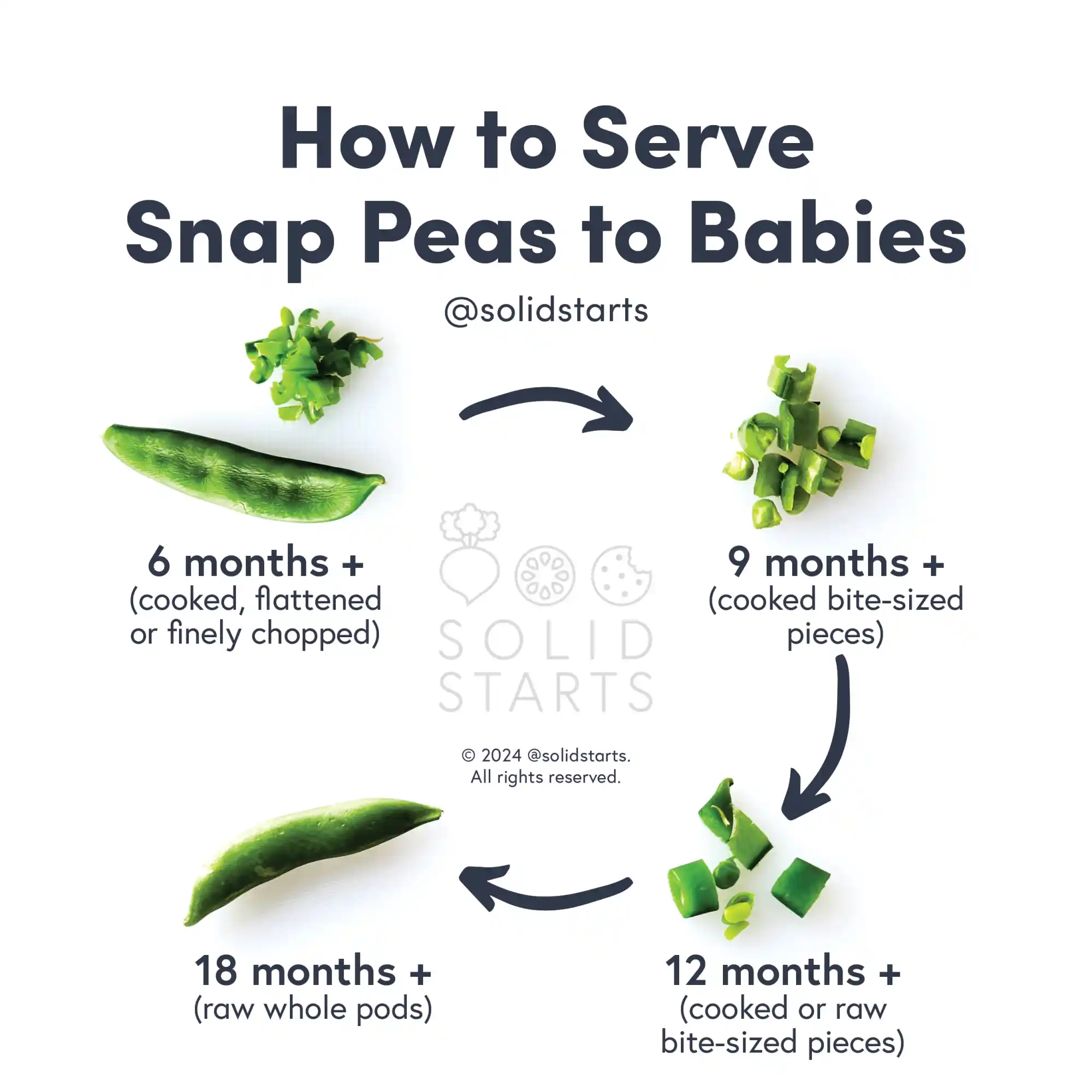Access our First Foods® Database in the Solid Starts App.
Learn moreSnap Pea
Legume
Age Suggestion
6 months
Iron-Rich
No
Common Allergen
No

When can babies have snap peas?
Snap peas, when cooked, may be introduced as soon as baby is ready to start solids, which is usually around 6 months of age. Whole raw pods and the peas inside them can pose a choking risk, so make sure to read our section on how to safely prepare snap peas for a child’s age and eating ability.
Snap peas and snow peas have a different flavor, shape, and size. Snap peas have round, thicker pods containing bigger peas. Snow peas have flat, thin pods containing smaller peas. Both snap peas and snow peas produce delicate flowers and sweet young sprouts that are featured in congees, curries, stir-fries, and many more dishes with roots in Asia, the native home of both legumes. Snap peas are also called “sugar snap peas” which hints at the sweeter taste than snow peas.
How do you serve snap peas to babies?
Every baby develops on their own timeline, and the suggestions on how to cut or prepare particular foods are generalizations for a broad audience.
6 months old +:
Remove the seam from each pod, then cook and finely chop snap peas to fold into soft foods that baby can scoop, such as congee and other warm porridges. Alternatively, offer the whole, cooked snap pea pod as a teether, but make sure to reduce the choking risk by flattening the pod with your hand or a fork to crush the peas inside. Just know that baby is not likely to get any food in the belly this way, but munching on the pod can help develop baby’s oral-motor skills.
9 months old +:
Cook and chop snap pea pods to offer on their own or as part of a meal. This size helps baby develop the pincer grasp, where the thumb and index finger meet.
12 months old +:
Offer bite-sized pieces of raw or cooked snap peas. If the child is doing well with chopped pieces of snap pea and you feel comfortable with it, offer whole snap peas for biting and chewing practice under close supervision. If the child doesn’t seem ready for whole snap peas, do not worry; this is likely to come closer to 18-24 months of age. Expect lots of spitting, since the fibrous pods are challenging to chew.
18 months old +:
Continue offering cooked whole or chopped snap peas, either on their own or as part of a meal. Many toddlers are now ready to eat whole, raw snap pea pods, with supervision. You can continue to flatten the peas in the pod a bit before offering to reduce the choking risk a bit. Snap peas are a great interactive food for toddlers: investigate how loud it crunches when you bite into it, or ask them how many peas they think are inside each pod.
Get lunch ideas for home or daycare with our guide 75 Lunches for Babies & Toddlers.
Videos
Are snap peas a choking hazard for babies?
Yes, the firm, round peas inside each pod can pose a risk of choking. To reduce the risk, prepare and serve snap peas in an age-appropriate way. As always, make sure you create a safe eating environment and stay within arm’s reach of baby during meals. For more information on choking, visit our sections on gagging and choking and familiarize yourself with the list of common choking hazards.
Are snap peas a common allergen?
No. Snap peas are not a common allergen. However, pea allergies have been reported in some patients with allergies to other legumes, particularly chickpea and lentil. Being allergic to one type of legume does not necessarily mean that an individual will be allergic to all others, although the risk of having more than one legume allergy can increase. Fortunately, most individuals with peanut or soy allergy (both common food allergens) are able to tolerate other legumes, such as snap peas, just fine.
Individuals with allergies to birch tree pollen and/or Oral Allergy Syndrome (also called pollen food allergy syndrome) may be sensitive to legumes. Oral Allergy Syndrome typically results in short-lived itching, tingling, or burning in the mouth and is unlikely to result in a dangerous reaction. Cooking snap peas can help minimize and even eliminate the reaction.
As you would when introducing any new food, start by offering a small quantity for the first few servings. If there is no adverse reaction, gradually increase the quantity over future meals.
Are snap peas healthy for babies?
Yes. Snap peas are a good source of folate and vitamins B6, C, and K, which collectively support neurodevelopment, metabolism, immune function, and healthy blood clotting. Plus, they offer fiber for digestive health and modest amounts of iron for baby’s red blood cells. Lastly, snap peas are rich in antioxidants, which help support the body’s resilience against stressors.
How much sugar is in snap peas?
An insignificant amount, despite often being called sugar snap peas. There is no need to limit snap pea intake based on sugar content, so offer as desired.
Are snap peas high in iron?
No. While snap peas offer a modest amount of iron, they aren’t considered an iron-rich food. However, snap peas are rich in vitamin C, which helps our bodies absorb plant-based iron (non-heme iron). Try serving sugar snap peas with a high-iron plant food such as beans or lentils to support baby’s iron levels.
Our Team
Written by
Expert Tips Delivered to Your Inbox
Sign up for weekly tips, recipes and more!






